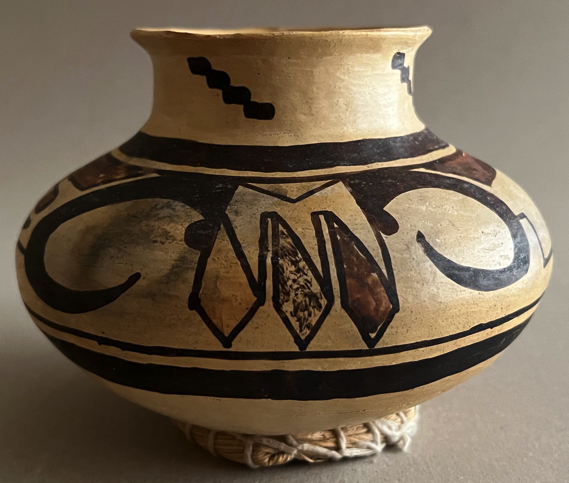
© 2010-2023 by Fine Arts of the Southwest, Inc. All rights reserved.
Unauthorized reproduction or use is strictly prohibited by law.
An exceptionally rare and beautiful historic
Hopi “Walpi Polychrome” type four-color polychrome pottery jar, c. 1880
This jar is one of the rarest ducks anywhere on any pond, an extremely difficult to come by, but an absolutely must have type of piece for every serious historic Hopi pottery collector, the elusive “Walpi Polychrome”, made from around 1375
to 1915. Walpi Polychrome, so named after the ancient Hopi village of Walpi on the tip of the Hopi First Mesa is the modern-era direct extension of the fabled ancient Hopi Pottery type of Sikyatki Polychrome (1375-1625 A.D.). But, when Sikyatki gradually died out, evolving into other types, beginning in the late 17th and early 18th Century, Walpi Polychrome pottery continued unchanged using the same materials, the same methods and the same general aesthetic as Sikyatki.
All throughout the next three centuries Walpi Polychrome existed as a small parallel tradition until dying out itself around 1915. The last true practitioner of Walpi Polychrome was the great Hopi pottery Matriarch Nampeyo (1859-1942) who made Walpi/Sikyatki type vessels in terms of materials, methods and aesthetics through the 1920’s. That said, even though it had been made for centuries, historic Walpi Polychrome pottery vessels are today extraordinarily rare, in the past 35 years we have seen perhaps only 15-20 of them and many of these were later pieces made by Nampeyo and her family, of true historic Walpi vessels pre-Nampeyo we have seen perhaps only six or eight in all including this one.
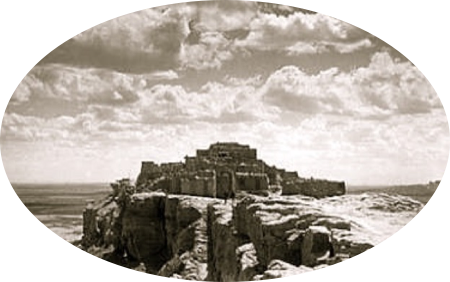
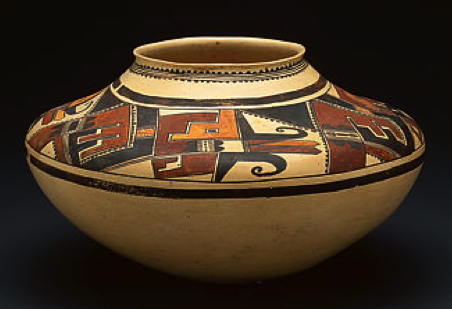
Sikyatki Four-Color Polychrome pottery jar, c. 1450-1500 A.D.
Photo source and © The Metropolitan Museum of Art
At left, Nampeyo's oldest daughter, Annie Healing, holding her daughter, Rachel.
At center, Nampeyo's mother, White Corn, and at right, Nampeyo, c. 1901.
Photo source and © Wikipedia

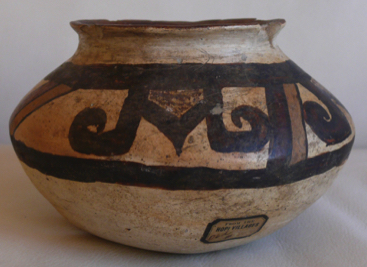
Now onwards to the particulars of this lovely diminutive jar; globular, round-bottomed shape, eagletail four-part symmetrical design field with twin pendant eagle tail and twin stylized bird and feather designs and one other fascinating characteristic also a holdover from a Sikyatki period subtype known as Kawaiika-a named after the ancient ruined Hopi village adjacent to Sikyatki where it was found and iidentified. Kawaiika-a Polychome pottery is often identifiable through the use of a fourth color in addition to the usual three; black and red paints against a yellowish-orange clay background, a lovely delicate pale pumpkin yellow which can be seen used sparingly on this vessel. There are also the characteristic two thick framing lines at the top and bottom of the design field and a spare upper neck design, in this case a series of four stacked diagonal terraced motifs. The pottery and its design are so uncanny and characteristic and so perfectly well done in the Sikyatki idiom that if you didn't know this jar was a later piece you would wear on a stack of bibles that it was four hundred plus years older than it really is.
The methods and materials of these two pottery types, Sikyatki and Walpi are straightforward, but not at all easy to use and especially to yield such a beautiful result. The clay is a very fine Hopi grey clay found in ancient clay beds on the Hopi Antelope Mesa at the far eastern end of the Hopi Reservation bordering Navajo lands. This clay is so fine and capable of being fired so strongly and durably that it does not require a tempering agent and therefore does not use one. Second, Walpi polychrome vessels like those of Sikyatki, are always unslipped, the clay body itself is so fine that when the vessel
is traditionally stone polished a “self” slip of sorts rises to the surface and becomes the actual slip. The paints are all hand ground from locally found Native minerals and plants such as beeweed.
The pottery firing on both Sikyatki and Walpi ceramics is always done with high-temperature Lignite coal also gathered from ancient deposits in the walls of Antelope Mesa. Coal firing is a difficult, unpredictable and painstaking method of pottery firing which reaches an extreme temperature unattainable through any other natural means such as using dung or wood,
a temperature which yields pottery vessels walls of extreme hardness and exceptional thinness allowing for the daring vessel shapes that characterized Sikyatki pottery and to a lesser extent that of Walpi until Nampeyo revived the extremely low-profile Sikytaki jar shape around 1890. This particular jar’s shape is a latter day interpretation of the traditional Sikyatki globular round-bottomed olla or water jar shape, a common and characteristic pottery shape used throughout
the Sikyatki era as well as previously in the Jedditio era and later in San Bernardo pottery as seen below.
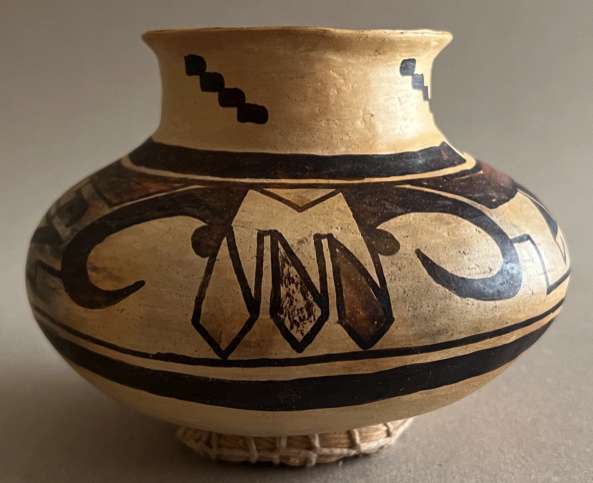
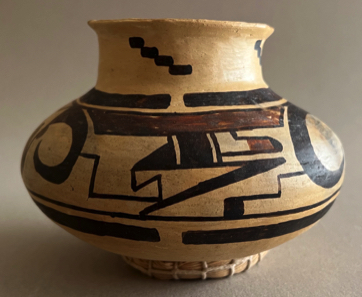

The jar measures 4” in height and is 5” in diameter, very similar in size and shape to several Sikyatki and slightly later
Hopi jars we have had as can be seen above at left. This size and shape has only limited practical use, perhaps to hold and store cornmeal or pigments or other rare valuable materials. The jar is in unusually excellent original condition overall and a thorough of the vessel under Ultraviolet light reveals no evidence of restoration or over-painting. There are two very slight slip cracks in the bottom which could be easily restored of desired, but in our view compete originality is always better particularly when it does not interfere with the visual enjoyment of the vessel and thus we would leave these alone. Otherwise, the piece is in remarkable original condition indicating to us that it was very likely collected early at
the source and kept safe and treasured ever since. Also, due to the jar’s traditionally-shaped round bottom, a display stand is required to display it sitting up striaght and level.
There were a steady stream of intrepid scientists; various archaeologists, anthropologists and ethnologists, artists
and tourists visiting Hopi in the early years of the 20th century and one of these could easily have bought this jar directly from White Corn or Nampeyo directly or from one of the several local Indian traders who sold their wares; Nampeyo’s brother Thomas Polacca, or the transplanted European traders Alexander Stephen or Thomas Varker Keam
or Juan Lorenzo (J.L.) Hubbell. Wherever it was obtained, the vessel is in absolutely remarkable shape, a unique and precious window in time back a century and a quarter to the lonely windswept high desert mesas of Hopi land.
This small jar is one of the finest, rarest and most beautiful historic Hopi ceramics one is ever likely to see, a unique,
once in a couple decades opportunity to acquire a true historic indigenous American ceramic masterpiece.
SOLD
Note: The pottery display stand shown here is for demonstration purposes
only and is not included in the sale of this pottery jar.

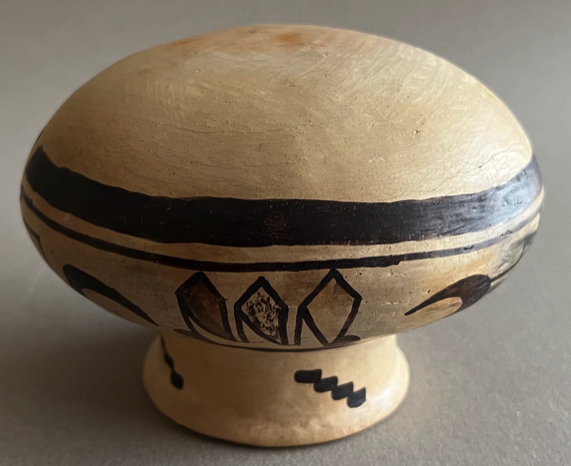
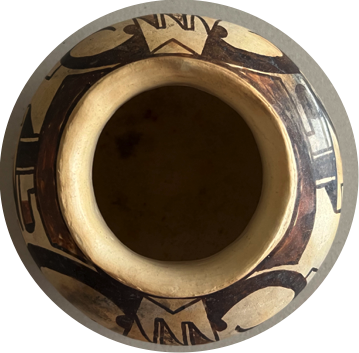
View of present-day Walpi Village on the Hopi First Mesa, two to three miles as the crow flies from the ancient ruins of Sikyatki village.
Photo source and © A.C. Vroman, 1901
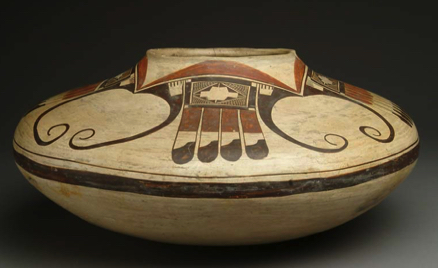
These are the materials and methods used here, the aesthetics are also quite similar though Walpi decorative motifs are less extreme and elaborate than those of Sikytaki. This particular vessel has a charcteristic four-part design composed
of two pairs of horizontally opposed similar panels. This design is commonly referred to as the “Eagle tail” design for its twin pendant hanging semicircular forms. this particular design has over time become closely associated with the Nampeyo family as seen above who discovered and "revived" it from Sikyatki and have used it continuously since the last quarter of the 19th century which brings us to the question of who might have made this particular vessel.
This jar has the eagletail design, but does not immediately appear to be by the hand of Nampeyo although it certainly
could have been, rather it appears to have been made by someone older and perhaps more deeply steeped in the older design tradition. Given the very small number of capable Hopi potters during this time period and given the use of what has become characteristic Nampeyo designs one can easily theorize that this jar might very well be the product of the skilled hands
of the great First Mesa potter and Corn Clan Matriarch, White Corn, who, in addition to being Nampeyo’s Mother, was a renowned potter in her own right and who taught her very-soon-to-become world famous daughter to make pottery.
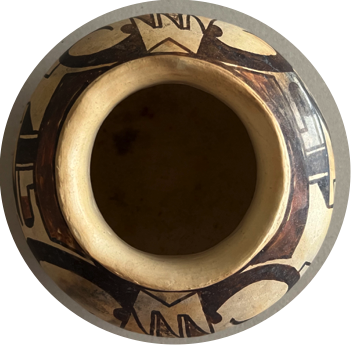
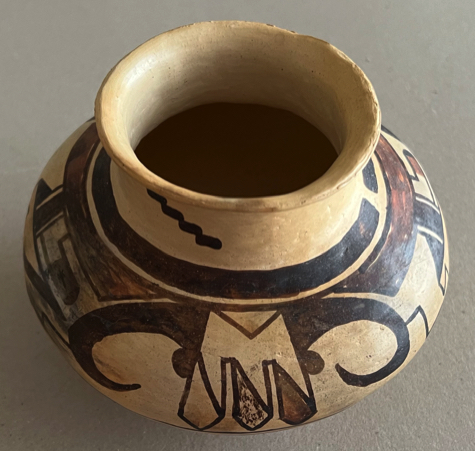
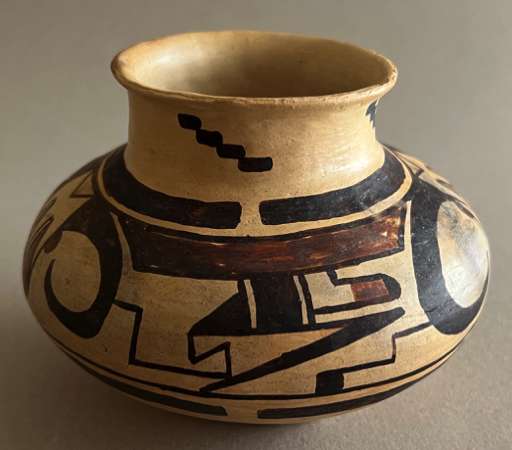
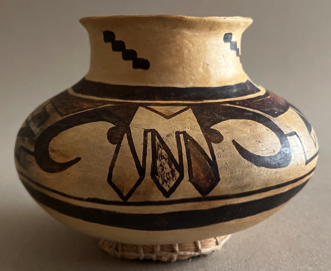
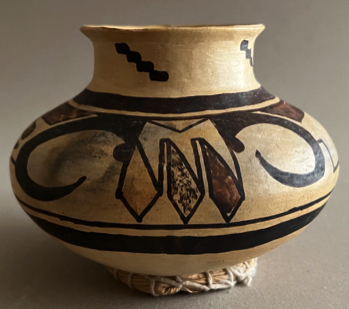
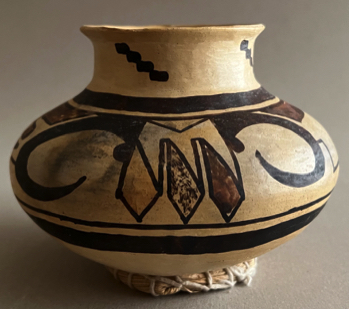
At left, a Hopi San Bernardo Polychrome type four-color pottery jar, c. 1680-1700 A.D., of a very similar size and shape and with a very similar pendant “Eagle-Tail” design scheme to this Walpi jar at right. Notice also the fourth color, a distinct pumpkin yellow, in addition to the usual creamy-yellow background and black and red paint also quite similar to that of this Walpi jar.
San Bernardo Polychrome pottery (1675- 1780 A.D.) is the next pottery type after Sikyatki Polychrome in the normal historic Hopi pottery sequence and it retains much of the same technical and aesthetic characteristics as Sikyatki, but generally the vessels are not as well formed or precisely painted.
Walpi Polychrome pottery existed as a parallel tradition to San Bernardo Polychrome and to the later historic Hopi Polychrome pottery types; Payupki, Polacca A, B, C & D, Hano etc. until dying out around 1915. At center, a later "Sikyatki-Revival" version of the "Eagle Tail" design by Nampeyo, c. 1905.
Center photo by Addison Doty, Santa Fe
